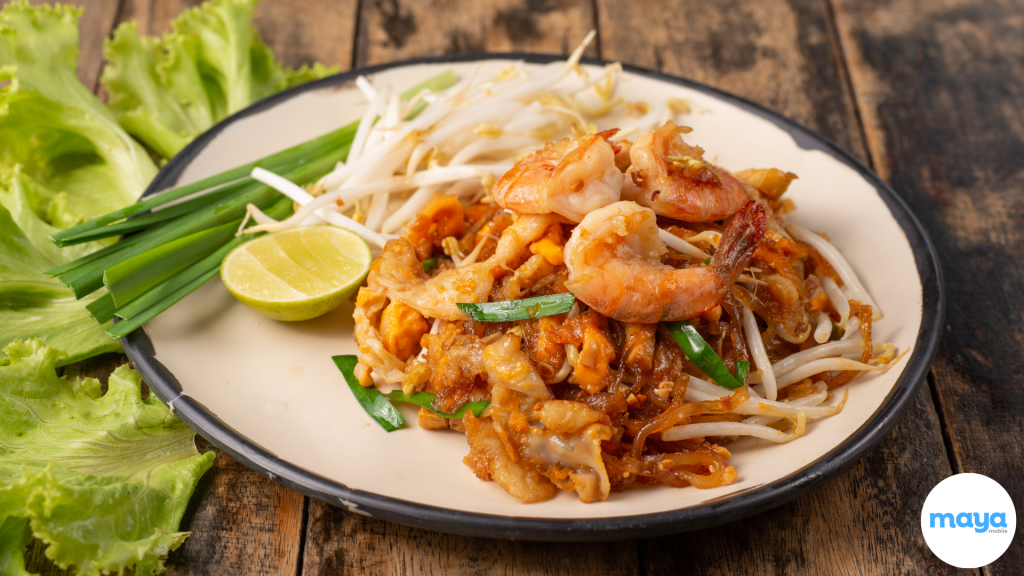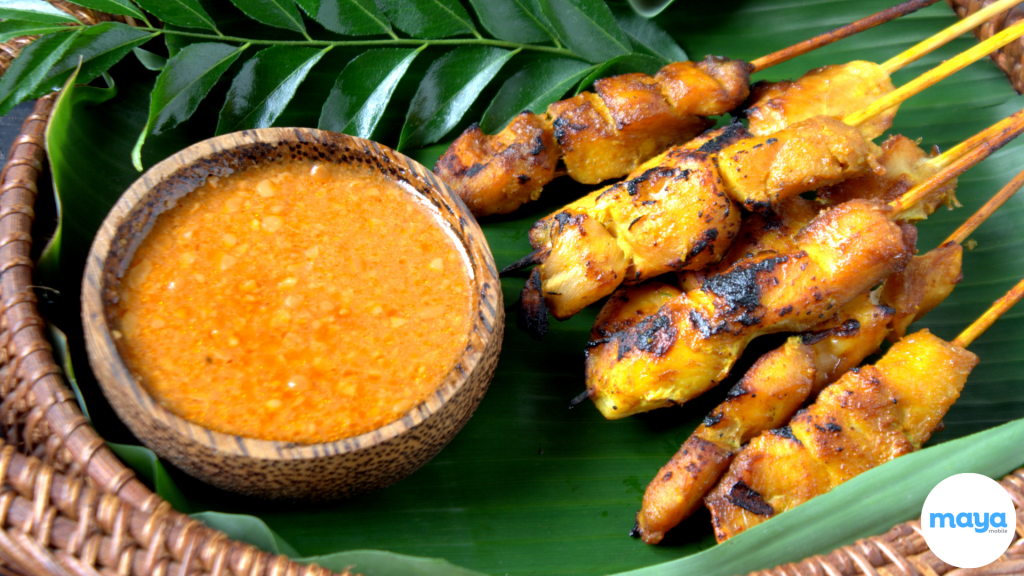Thailand is known for its beautiful places, rich history, and delicious thai food dishes. From the busy streets of Bangkok to the calm beaches of Phuket, there’s something for everyone. It’s a great spot for travelers to see old temples and try new things.
Beyond the beautiful sights, promises a delightful experience. Prepare your taste buds for a delightful journey through its iconic cuisine.
Thai food is renowned for its diverse flavors and spices. Each dish tells a story of Thailand’s rich cultural heritage. Let’s explore the dishes that every food lover must give a try. Whether you’re a seasoned traveler or a first-time visitor, here are 20 essential Thai dishes you can’t miss.
Tom Yum Goong


Tom Yum Goong is a spicy and sour shrimp soup that originated in central Thailand, particularly where freshwater shrimp were abundant. It’s a significant dish in Thai cuisine, often served in both daily meals and at festivals. This dish showcases the essence of Thai cooking by balancing spicy, sour, and slightly sweet flavors.
Key ingredients include lemongrass, kaffir lime leaves, galangal, chilies, and shrimp, which create a rich aroma and bold taste. The soup is known for its spicy and sour combination, with lime juice adding tanginess and shrimp providing sweetness.
Tom Yum Goong is low in calories and rich in protein from shrimp. It’s also gluten-free, making it suitable for a wide range of diets. Additionally, the herbs used have various health benefits, such as aiding digestion and boosting immunity.
Pad Thai


Pad Thai is a popular dish in Thailand, and it is known for its delightful mix of flavors. It typically includes stir-fried rice noodles mixed with eggs and a choice of protein like tofu, shrimp, or chicken, seasoned with tamarind paste and fish sauce. This dish is often garnished with peanuts, garlic, and lime, allowing eaters to adjust the taste to their liking.
Originating from the street stalls of Thailand, Pad Thai is a staple at both everyday meals and special festivals, celebrated for its easy customization and quick preparation.
The flavor of Pad Thai is a vibrant mix of sweet, sour, and savory, which appeals to a broad range of palates. Key ingredients like tamarind and fish sauce provide a distinct aroma and taste that is both refreshing and bold.
Pad Thai can be a nutritious choice as it often includes a good balance of protein and veggies, making it adaptable to various diets, including gluten-free options, by substituting specific sauces or noodles.
Som Tum


Som Tum is traditionally served as part of everyday meals or at festivals, often paired with grilled chicken or sticky rice. A spicy green papaya salad from northeastern Thailand is loved for its fresh, bold flavors.
The salad is made with shredded green papaya, tomatoes, carrots, peanuts, string beans, lime, fish sauce, garlic, and Thai chilies. The flavors combine spicy, sour, salty, and sweet in a vibrant, refreshing way.
Many Americans find this dish unexpectedly refreshing, despite the heat. One taster commented that while the spice was intense, the balance of lime and crunchiness made it an enjoyable experience. It’s often enjoyed with grilled chicken or sticky rice, making it a balanced meal.
Som Tum is low in calories and packed with fiber, thanks to the papaya and veggies. It’s naturally gluten-free and can be made low-carb by adjusting the sugar. Plus, the salad provides a good dose of vitamins A and C, with peanuts adding a bit of protein and healthy fats.
Kai Med Ma Muang


This popular dish Kai Med Ma Muang features stir-fried chicken with cashews, soy sauce, honey, onions, and sometimes bell peppers, creating a delightful mix of sweet and savory. It’s a great entry point for those new to Thai food, as it’s less spicy but full of flavor.
This dish is commonly served in everyday meals and occasionally at festivals, offering a taste-friendly introduction to Thai cuisine for newcomers. Key ingredients include chicken, cashews, soy sauce, honey, and onions.
The dish offers a balance of sweet and savory flavors with a hint of spiciness. Its aroma is inviting, characterized by the nuttiness of roasted cashews and the sweetness of honey.
Thai Chicken Satay


Thai Chicken Satay, a popular dish from Thailand, typically graces street markets and festive gatherings. It features chicken marinated in a blend of lemongrass, turmeric, garlic, and curry powder, then grilled to bring out a smoky flavor. This is often paired with a homemade peanut sauce that adds a creamy texture and a sweet and tangy taste, complementing the spices of the marinade.
The main components that define this dish include chicken for a protein-rich base, lemongrass and garlic for a burst of freshness, turmeric for color and a hint of bitterness, and curry powder for a deep, spicy flavor. The overall taste profile is a balanced mix of spicy, sweet, and tangy, enriched by the creamy peanut sauce.
The health benefits of Thai Chicken Satay come from its high protein content and the anti-inflammatory effects of turmeric and garlic, supporting wellness. Traditionally, Thai Chicken Satay is more than just a meal; it’s a part of communal enjoyment, often found in social gatherings and celebrations across Thailand, highlighting its cultural significance.
Khao Soi
Khao Soi is a must-try for anyone visiting Chiang Mai. Khao Soi is typically served in a bowl with a rich and creamy curry broth, egg noodles, and a variety of toppings. These toppings can include crispy fried noodles, pickled mustard greens, shallots, lime wedges, and chili oil.
The key ingredients in Khao Soi are egg noodles, a curry broth made from coconut milk, and spices like turmeric, ginger, chili peppers, and crispy fried noodles. Many Indians find this dish particularly comforting, as it shares similarities with Indian curries in its use of rich spices and coconut milk.
The added crunch of crispy noodles gives it a unique texture that appeals to those who enjoy complex flavors and hearty soups. It’s perfect for those who enjoy creamy and spicy flavors.
Thai Fillet of Fish Baked in Banana Leaf
This dish involves marinating fish fillets in a fragrant curry paste mixed with coconut cream, then wrapping and baking them in banana leaves. The banana leaves impart a subtle smoky flavor while keeping the fish moist.
Thai fillet of fish baked in banana leaf is typically served as a main course, often accompanied by rice or noodles. The fish is wrapped in a banana leaf and baked until cooked through, giving it a unique smoky flavor.
The key ingredients in this dish are fish fillets, a spicy curry paste made from ingredients like chili peppers, turmeric, lemongrass, coconut cream, and banana leaves. The curry paste imparts a rich and spicy flavor to the fish, while the coconut cream adds a creamy texture. The banana leaf adds a subtle smoky aroma and helps to keep the fish moist.
Pad Krapow Moo Saap
Pad Krapow Moo Saap is a street food that offers a spicy kick from fresh chili and a robust flavor from holy basil. Served over rice with a runny fried egg on top, it’s a simple yet satisfying meal that embodies the essence of Thai street food culture.
This dish is typically served over rice, with a fried egg on top. It’s a common street food option and is often enjoyed as a quick and satisfying meal.
The key ingredients in Pad Krapow Moo Saap are pork, chili peppers, holy basil, and soy sauce. The dish is characterized by its spicy flavor, coming from the chili peppers. The holy basil adds a unique aroma and a slight bitterness. The soy sauce provides a salty and savory taste.
Pad Krapow Moo Saap provides a good amount of protein from the pork, which supports muscle growth and repair. The holy basil and chili peppers in the dish contain antioxidants and anti-inflammatory properties.
Pla Pao
Pla Pao is a classic Thai dish perfect for a casual, outdoor meal. Imagine a whole fish grilled to perfection over an open flame, served with a tangy, spicy sauce made from fresh coriander and chili peppers. It’s a humble yet delightful dish that’s packed with flavor.
The key ingredients in Pla Pao are a whole fish, typically a freshwater fish like tilapia or catfish, and a coriander-chili sauce. The sauce is made from fresh coriander, chili peppers, lime juice, and other seasonings. The dish is also a healthy choice as it’s made from whole fish, which is a great source of lean protein and omega-3 fatty acids.
Africans trying this dish in a new setting noted that while they were unsure of how it would taste due to the whole fish presentation, they were amazed by the balance of the spice in the sauce and how well it complemented the fish. They praised it as one of the standout seafood dishes they’ve had since trying Thai cuisine. The dish is often enjoyed on the beach or as a rustic meal in local eateries.
Steamed Thai Sticky Rice
Traditionally, Thai sticky rice is a daily staple and a key feature in festive celebrations. It’s commonly eaten by hand, rolled into small balls, and dipped into sauces or served with side dishes. This dish uses glutinous rice, which gives it a sticky texture perfect for pairing with savory or sweet accompaniments.
It can be combined with Mango Sticky Rice, Grilled Meats, Papaya Salad (Som Tam), or Laab. The main ingredient is glutinous rice, which provides a mildly sweet taste and a chewy texture. Sticky rice absorbs the flavors it’s paired with, enhancing its natural sweetness.
Sticky rice is a good source of carbohydrates, which provide energy for your body. While it’s filling and satisfying, it’s also gluten-free, making it suitable for those with gluten sensitivities.
Larb Gai
Larb Gai is a traditional Thai minced chicken salad known for its bold flavors. This combination gives Larb Gai its distinctive taste—spicy from the chili, sour from the lime juice, and slightly salty from the fish sauce, with an earthy crunch from the roasted rice.
American tasters found the “meat salad” concept unique and particularly enjoyed the balance of lime, cilantro, and spiciness, with one remarking, “I get why they larb it!” This dish is both healthy and delicious.
Indians accustomed to spicy, tangy, and herbaceous flavors tend to appreciate Larb Gai for its bold use of lime and chilies, which brings to mind dishes like chaat or kachumber (Indian salads). The bright, fresh herbs add another layer of flavor, making it a favorite for those who enjoy light but spicy food.
Pad See Ew
Pad See Ew originated in Bangkok, and is known for its sweet-savory flavor and chewy noodles. This dish is typically made with broad, flat rice noodles, Chinese broccoli, and a protein like pork, chicken, or tofu.
The dish is usually served with chili flakes for those who prefer a spicier taste. Adding a squeeze of lime or lemon is common for a tangy flavor.
The key ingredients in Pad See Ew are rice noodles, dark soy sauce, Chinese broccoli, and protein. The dish is stir-fried with ingredients that create a sweet-savory flavor.
Pad See Ew is a great source of energy due to the high carbohydrate content of the rice noodles. The inclusion of Chinese broccoli adds a healthy dose of vitamins A and C, which are important for vision and immune health, respectively, making it a balanced and nutritious meal.
Panang Curry
Panang Curry is known for its rich, creamy texture and mild heat. It’s a great option for those who enjoy flavorful but not overly spicy food. It’s often served as a main course, accompanied by rice or noodles.
The key ingredients in Panang Curry are curry paste, coconut milk, meat (often beef or chicken), peanuts, and often vegetables like bell peppers or bamboo shoots. These ingredients combine to create a flavorful and satisfying dish.
The taste of Panang Curry is a balance of sweet, salty, and spicy flavors. The curry paste provides a rich and complex flavor, while the coconut milk adds a creamy texture.
Waterfall Beef Salad
Thai Waterfall Beef Salad, or “Nam Tok,” gets its name from the sound of the juice sizzling on the grill when cooking. This refreshing dish features thinly sliced grilled beef dressed with lime juice, fish sauce, and chili flakes, giving it a slightly spicy kick.
The main components include grilled beef, lime juice, fish sauce, fresh herbs like mint, and chili flakes. The salad offers a vibrant mix of flavors—spicy from the chili, sour from the lime, and savory from the fish sauce. The freshness of herbs balances the richness of the beef, creating a deliciously complex taste.
Thai Waterfall Beef Salad is a nutritious choice because it’s rich in protein from the beef, which supports muscle growth and repair. Additionally, fresh herbs and lime juice provide vitamin C and antioxidants, which can enhance your immune system and reduce inflammation, making it a refreshing and healthful dish.
Hor Mok
Hor Mok is a delicious Thai dish that features fish mixed with red curry paste and coconut milk. It is steamed in banana leaves, giving it a soft, custard-like texture that melts in your mouth.
Hor Mok is often enjoyed during special occasions, family gatherings, and festivals. It has a harmonious blend of flavors—spicy from the red curry paste, creamy from the coconut milk, and aromatic from the herbs.
The dish offers a comforting taste that balances sweetness and heat. It’s a nutritious option, providing a good source of protein from the fish and healthy fats from the coconut milk.
Miang Kum
Miang Kum is a small lettuce wrap filled with a mixture of shrimp, coconut, peanuts, and chili. These ingredients combine to create a flavorful and satisfying snack.
The taste of Miang Kum is a complex blend of sweet, salty, spicy, and sour flavors. The crunchy lettuce leaves provide a refreshing base for the flavorful filling.
The shrimp adds a protein punch, while the roasted coconut and peanuts provide a satisfying crunch. The lettuce leaves are a good source of vitamins and minerals, while the shrimp and peanuts provide protein.
Khanom Krok
Khanom Krok is a beloved Thai street food snack that’s perfect for a quick and tasty treat. These small, sweet pancakes are made with a batter of coconut milk and rice flour, giving them a unique coconut flavor and a crispy exterior.
It’s often enjoyed as a casual snack or dessert, but it can also be found at festivals and special occasions. The key ingredients in Khanom Krok are coconut milk, rice flour, sugar, and eggs. These ingredients combine to create a batter that is light and airy with a subtle sweetness.
African tasters enjoyed these pancakes immensely, comparing them to familiar local snacks. The crispy exterior combined with the soft center and sweetness of the coconut created a comforting street food experience, with some mentioning that this was a dish they would come back to again and again. They’re a popular street food snack, often enjoyed freshly made by vendors.
Khanom Krok can be a healthier snack choice due to its main ingredients, coconut milk and rice flour. Coconut milk is rich in vitamins and minerals, which can boost your immune system, while rice flour is gluten-free and easy to digest.
Thai Weeping Tiger Beef
Weeping Tiger Beef is a great option for those who enjoy bold flavors and a hint of heat. It’s often served as a main course, accompanied by rice or noodles. You might also find it at special occasions or street food stalls.
The key ingredients in Weeping Tiger Beef are beef, soy sauce, fish sauce, sugar, garlic, chili peppers, and often a touch of lime juice. These ingredients combine to create a marinade that is sweet, salty, and slightly spicy.
The accompanying dipping sauce is a spicy and tangy mixture of chili peppers, vinegar, sugar, and garlic. It adds a burst of flavor to the beef and helps to balance the richness of the meat.
Weeping Tiger Beef is packed with protein from the beef, making it an excellent option for muscle building and repair. The use of garlic and chili peppers not only enhances flavor but also offers health benefits such as boosting the immune system and improving metabolism, which can aid in weight management.
Bangkok-Style Drunken Noodles
Bangkok-Style Drunken Noodles, or Pad Kee Mao, is a great option for those who enjoy a flavorful and satisfying meal. The key ingredients in Drunken Noodles are rice noodles, meat (often pork or beef), chili peppers, soy sauce, fish sauce, sugar, garlic, and often vegetables like broccoli or bell peppers. These ingredients combine to create a flavorful and satisfying dish.
This dish is for those who love a fiery flavor, featuring rice noodles stir-fried with basil, chili, and a choice of meat. Americans who tried this dish found it to be one of the spiciest, yet most flavorful meals they’ve had. Despite the heat, many loved the balance of the chili and basil, with one remarking it was “spicy but addictive.”
The taste of Drunken Noodles is a balance of sweet, salty, and spicy flavors. The noodles are chewy and absorb the savory sauce, while the meat adds a protein punch. The chili peppers provide a spicy kick, and the vegetables add color and texture.
Drunken Noodles provide a good source of energy from the rice noodles, which are carbohydrate-rich. This dish also incorporates various vegetables and herbs, which add essential nutrients and antioxidants.
Thai Desserts
To truly cap off your culinary adventure in Thailand, don’t forget to end your Thai food journey with a sweet treat.
Mango Sticky Rice, made with glutinous rice, ripe mangoes, and coconut milk, offers a refreshing and sweet end to your meal.
Black Sticky Rice Pudding provides a healthier dessert option, made with black sticky rice and coconut milk, and topped with fresh fruit.
Mango Sticky Rice provides vitamins from the mango and healthy fats from the coconut milk, making it a nourishing treat. Black Sticky Rice Pudding is rich in fiber and antioxidants, promoting digestive health and supporting the immune system.
Here’s a table categorizing some of the popular Thai dishes based on whether they are vegetarian, non-vegetarian, or vegan-friendly:
| Dish | Category |
| Tom Yum Goong | Non-Vegetarian, Gluten-Free |
| Kai Med Ma Muang | |
| Thai Chicken Satay | |
| Thai Fillet of Fish | |
| Pla Pao | |
| Larb Gai | |
| Panang Curry | |
| Waterfall Beef Salad | |
| Hor Mok | |
| Pad Thai | Non-Vegetarian |
| Pad Krapow Moo Saap | |
| Pad See Ew | |
| Miang Kum | |
| Thai Weeping Tiger Beef | |
| Bangkok-Style Drunken Noodles | |
| Khao Soi | |
| Mango Sticky Rice | Vegetarian, Vegan-Friendly, Gluten-Free |
| Black Sticky Rice Pudding | |
| Som Tum | |
| Khanom Krok | |
| Steamed Thai Sticky Rice | |
| Khanom Krok | Vegetarian |
- These dishes can be modified to be vegetarian or even vegan by substituting the protein with tofu and ensuring no fish sauce or shrimp paste is used.
- Make sure no fish sauce or shrimp paste is used for a truly vegan version.
Travel Tips for Exploring Thailand Beyond the Food
- Limited Connectivity Options: While traveling in Thailand, staying connected is challenging, especially in remote areas. Relying on traditional physical SIM cards often leads to the inconvenience of swapping cards and searching for compatible networks,
Choosing an eSIM lets you easily stay connected wherever you are. An eSIM (embedded SIM) allows you to access local networks without the need for physical SIM cards, offering a hassle-free and flexible alternative. This digital SIM is activated directly on your device, enabling you to switch carriers or plans according to your location without changing SIM cards.
- Respect Local Customs and Traditions: Thailand has a rich cultural heritage, so it’s important to be mindful of traditions. For example, always remove your shoes before entering temples and homes, and dress modestly, especially when visiting religious sites. Wearing appropriate clothing, such as covering shoulders and knees, is essential when entering temples.
- Learn Basic Thai Phrases: While many people in tourist areas speak English, learning a few simple Thai phrases can go a long way in showing respect to the locals. Phrases like “Sawasdee” (Hello) and “Khop khun” (Thank you) are easy to remember and will be appreciated.
- Beware of Scams: As in many tourist destinations, be cautious of common scams, such as overpriced taxis or tuk-tuks, especially around popular attractions. Always agree on a price before getting into a taxi or tuk-tuk, and consider using ride-hailing apps like Grab for fair pricing.
- Plan for Transportation: Thailand offers various transportation options, including tuk-tuks, buses, and trains. Tuk-tuks are fun for short trips, but for longer journeys, buses or trains are more reliable. In big cities like Bangkok, the BTS Skytrain and MRT subway are efficient and affordable ways to get around.
- Pack for the Climate: Thailand is a tropical country, so be prepared for hot and humid weather. Lightweight, breathable clothing is a must, and don’t forget to pack sunscreen, a hat, and insect repellent. If you plan to visit during the rainy season (June to October), bring an umbrella or raincoat.
While exploring Thailand’s amazing food, staying connected can be tough, especially in remote areas. Simplify your travel with eSIMs, and enjoy two lines on one device, hassle-free. No more switching SIMs or paying roaming fees.
FAQs on Thai Food Dishes
- What are the most popular Thai foods?
Some of the most popular Thai dishes include Pad Thai (stir-fried noodles), Tom Yum Goong (spicy shrimp soup), Som Tum (green papaya salad), Massaman Curry, and Green Curry. These dishes are known for their rich flavors, combining sweet, sour, salty, and spicy elements.
- What is traditional food in Thailand?
Traditional Thai food includes dishes like Tom Yum (a hot and sour soup), Gaeng Keow Wan (green curry), Pad Kra Pao (stir-fried basil with meat), and Jasmine rice served with various curries, soups, and stir-fries. These meals often feature fresh herbs, chilies, lime, and fish sauce.
- What is the best Thai food for beginners?
For beginners, Pad Thai is a great choice. It’s a mildly spicy, sweet, and savory noodle dish that’s widely loved. Chicken Satay (grilled chicken skewers with peanut sauce) is another beginner-friendly option, as is Mango Sticky Rice for dessert.
- What is the national dish of Thailand?
The national dish of Thailand is Pad Thai, a flavorful stir-fried noodle dish made with shrimp or chicken, eggs, tofu, peanuts, and a tamarind-based sauce.
- Are there vegan Thai dishes?
Yes, there are vegan Thai dishes such as Som Tum (without fish sauce), Steamed Thai Sticky Rice, Khanom Krok, Mango Sticky Rice, and Black Sticky Rice Pudding.
- Which Thai curries are vegetarian?
Thai curries like Green Curry and Massaman Curry can be made vegetarian by using tofu instead of meat and ensuring no fish sauce or shrimp paste is used.
- What Thai dish is gluten-free?
Gluten-free Thai dishes include Tom Yum Goong, Som Tum, Thai Fillet of Fish, Pla Pao, Larb Gai, Waterfall Beef Salad, Hor Mok, Khanom Krok, Mango Sticky Rice, and Black Sticky Rice Pudding. Ensure no soy sauce or other gluten-containing sauces are used.




